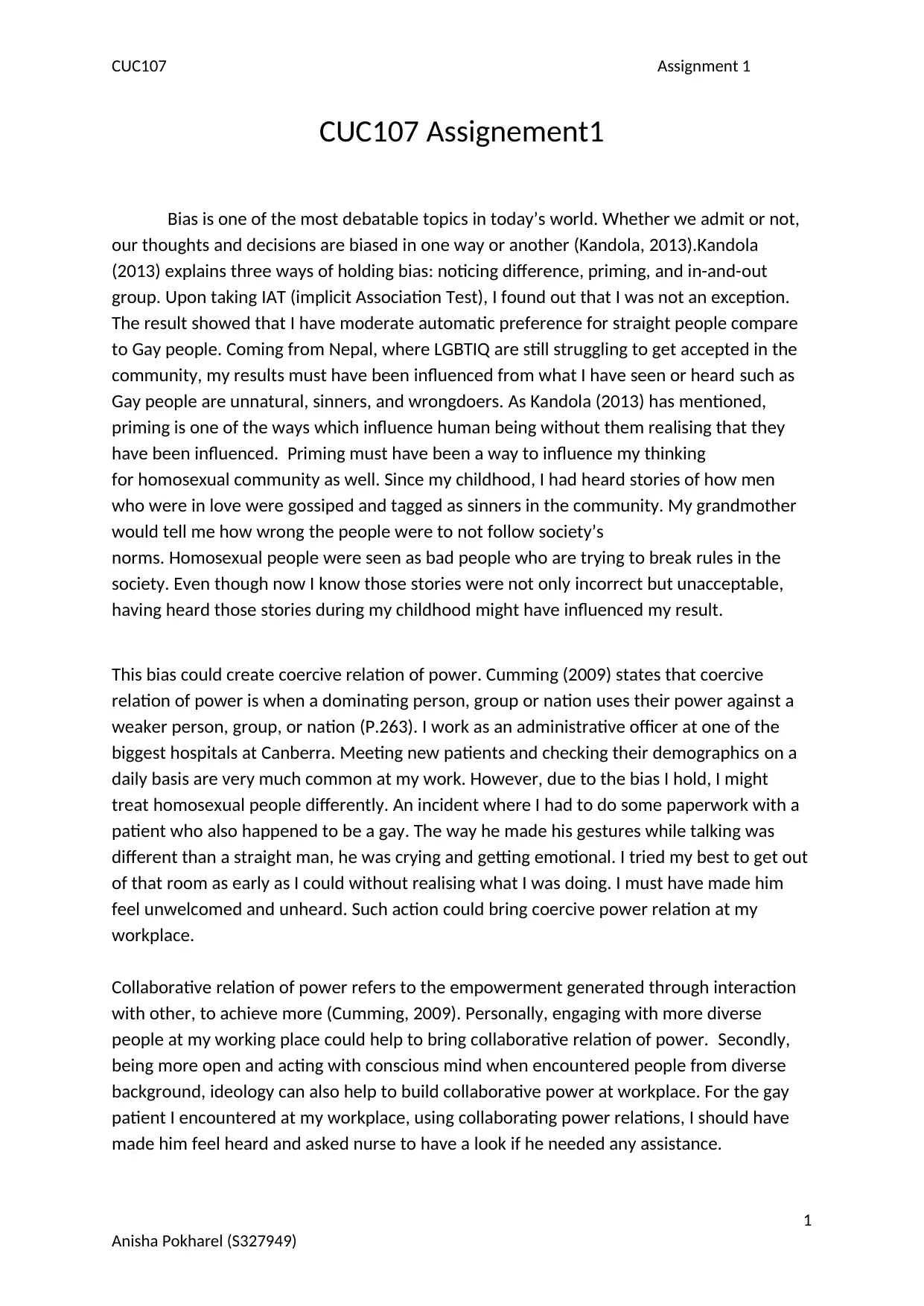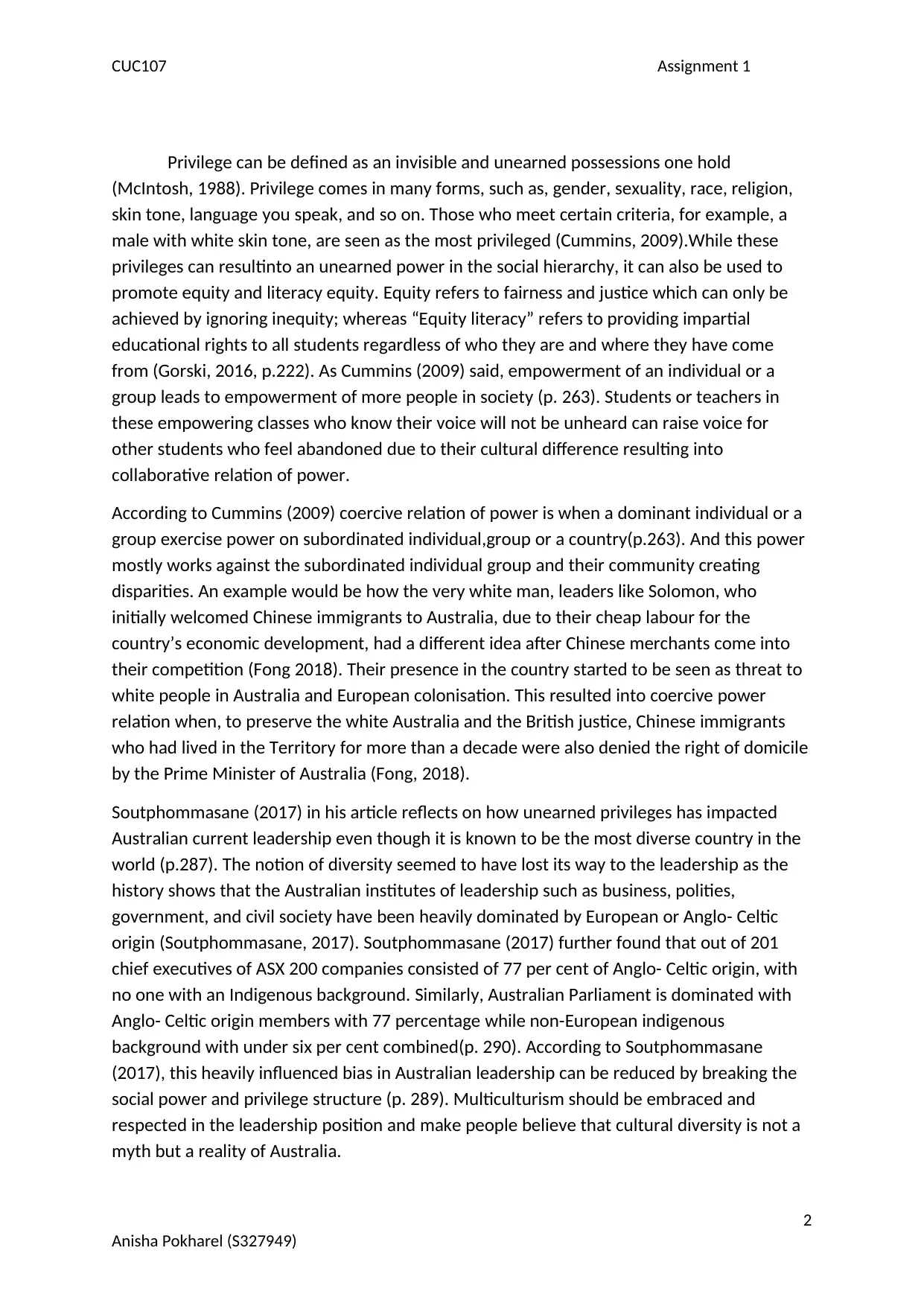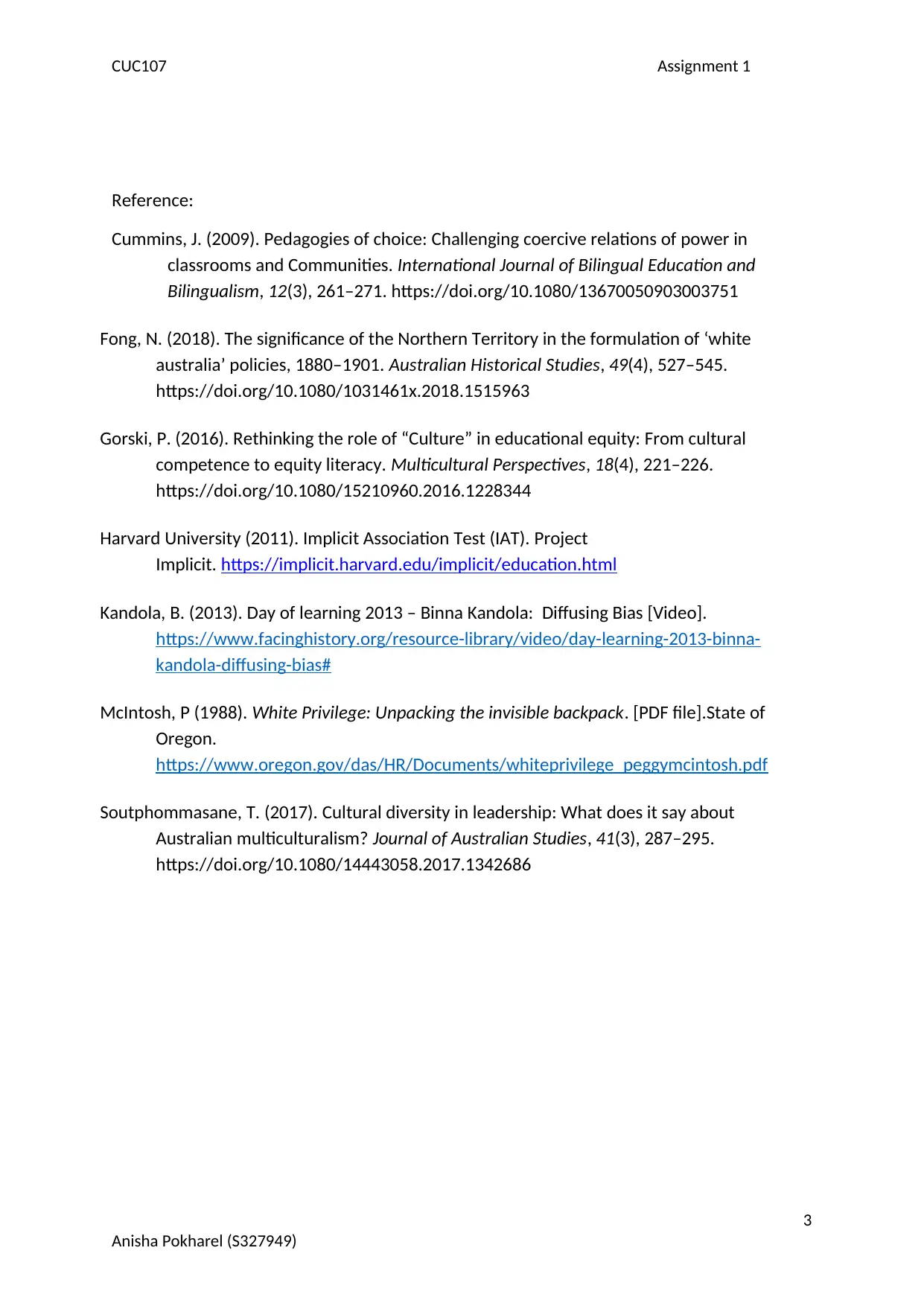CUC107 Assignment 1: Examining Bias, Power Relations, and Privilege
VerifiedAdded on 2023/01/31
|3
|1367
|92
Homework Assignment
AI Summary
This assignment explores the concepts of bias, power dynamics, and privilege through the lens of personal experiences and societal structures. The author reflects on their own implicit biases, as revealed by an Implicit Association Test, and how these biases might influence their interactions with others, particularly in a professional setting. The assignment examines coercive and collaborative relations of power, highlighting how bias can create disparities and impact individuals. It also discusses the concept of privilege, its various forms, and its influence on social hierarchies. The author further analyzes how unearned privileges have affected Australian leadership. The assignment references key academic sources to support its arguments, offering a comprehensive understanding of these critical social issues and their implications.

CUC107 Assignment 1
CUC107 Assignement1
Bias is one of the most debatable topics in today’s world. Whether we admit or not,
our thoughts and decisions are biased in one way or another (Kandola, 2013).Kandola
(2013) explains three ways of holding bias: noticing difference, priming, and in-and-out
group. Upon taking IAT (implicit Association Test), I found out that I was not an exception.
The result showed that I have moderate automatic preference for straight people compare
to Gay people. Coming from Nepal, where LGBTIQ are still struggling to get accepted in the
community, my results must have been influenced from what I have seen or heard such as
Gay people are unnatural, sinners, and wrongdoers. As Kandola (2013) has mentioned,
priming is one of the ways which influence human being without them realising that they
have been influenced. Priming must have been a way to influence my thinking
for homosexual community as well. Since my childhood, I had heard stories of how men
who were in love were gossiped and tagged as sinners in the community. My grandmother
would tell me how wrong the people were to not follow society’s
norms. Homosexual people were seen as bad people who are trying to break rules in the
society. Even though now I know those stories were not only incorrect but unacceptable,
having heard those stories during my childhood might have influenced my result.
This bias could create coercive relation of power. Cumming (2009) states that coercive
relation of power is when a dominating person, group or nation uses their power against a
weaker person, group, or nation (P.263). I work as an administrative officer at one of the
biggest hospitals at Canberra. Meeting new patients and checking their demographics on a
daily basis are very much common at my work. However, due to the bias I hold, I might
treat homosexual people differently. An incident where I had to do some paperwork with a
patient who also happened to be a gay. The way he made his gestures while talking was
different than a straight man, he was crying and getting emotional. I tried my best to get out
of that room as early as I could without realising what I was doing. I must have made him
feel unwelcomed and unheard. Such action could bring coercive power relation at my
workplace.
Collaborative relation of power refers to the empowerment generated through interaction
with other, to achieve more (Cumming, 2009). Personally, engaging with more diverse
people at my working place could help to bring collaborative relation of power. Secondly,
being more open and acting with conscious mind when encountered people from diverse
background, ideology can also help to build collaborative power at workplace. For the gay
patient I encountered at my workplace, using collaborating power relations, I should have
made him feel heard and asked nurse to have a look if he needed any assistance.
1
Anisha Pokharel (S327949)
CUC107 Assignement1
Bias is one of the most debatable topics in today’s world. Whether we admit or not,
our thoughts and decisions are biased in one way or another (Kandola, 2013).Kandola
(2013) explains three ways of holding bias: noticing difference, priming, and in-and-out
group. Upon taking IAT (implicit Association Test), I found out that I was not an exception.
The result showed that I have moderate automatic preference for straight people compare
to Gay people. Coming from Nepal, where LGBTIQ are still struggling to get accepted in the
community, my results must have been influenced from what I have seen or heard such as
Gay people are unnatural, sinners, and wrongdoers. As Kandola (2013) has mentioned,
priming is one of the ways which influence human being without them realising that they
have been influenced. Priming must have been a way to influence my thinking
for homosexual community as well. Since my childhood, I had heard stories of how men
who were in love were gossiped and tagged as sinners in the community. My grandmother
would tell me how wrong the people were to not follow society’s
norms. Homosexual people were seen as bad people who are trying to break rules in the
society. Even though now I know those stories were not only incorrect but unacceptable,
having heard those stories during my childhood might have influenced my result.
This bias could create coercive relation of power. Cumming (2009) states that coercive
relation of power is when a dominating person, group or nation uses their power against a
weaker person, group, or nation (P.263). I work as an administrative officer at one of the
biggest hospitals at Canberra. Meeting new patients and checking their demographics on a
daily basis are very much common at my work. However, due to the bias I hold, I might
treat homosexual people differently. An incident where I had to do some paperwork with a
patient who also happened to be a gay. The way he made his gestures while talking was
different than a straight man, he was crying and getting emotional. I tried my best to get out
of that room as early as I could without realising what I was doing. I must have made him
feel unwelcomed and unheard. Such action could bring coercive power relation at my
workplace.
Collaborative relation of power refers to the empowerment generated through interaction
with other, to achieve more (Cumming, 2009). Personally, engaging with more diverse
people at my working place could help to bring collaborative relation of power. Secondly,
being more open and acting with conscious mind when encountered people from diverse
background, ideology can also help to build collaborative power at workplace. For the gay
patient I encountered at my workplace, using collaborating power relations, I should have
made him feel heard and asked nurse to have a look if he needed any assistance.
1
Anisha Pokharel (S327949)
Paraphrase This Document
Need a fresh take? Get an instant paraphrase of this document with our AI Paraphraser

CUC107 Assignment 1
Privilege can be defined as an invisible and unearned possessions one hold
(McIntosh, 1988). Privilege comes in many forms, such as, gender, sexuality, race, religion,
skin tone, language you speak, and so on. Those who meet certain criteria, for example, a
male with white skin tone, are seen as the most privileged (Cummins, 2009).While these
privileges can resultinto an unearned power in the social hierarchy, it can also be used to
promote equity and literacy equity. Equity refers to fairness and justice which can only be
achieved by ignoring inequity; whereas “Equity literacy” refers to providing impartial
educational rights to all students regardless of who they are and where they have come
from (Gorski, 2016, p.222). As Cummins (2009) said, empowerment of an individual or a
group leads to empowerment of more people in society (p. 263). Students or teachers in
these empowering classes who know their voice will not be unheard can raise voice for
other students who feel abandoned due to their cultural difference resulting into
collaborative relation of power.
According to Cummins (2009) coercive relation of power is when a dominant individual or a
group exercise power on subordinated individual,group or a country(p.263). And this power
mostly works against the subordinated individual group and their community creating
disparities. An example would be how the very white man, leaders like Solomon, who
initially welcomed Chinese immigrants to Australia, due to their cheap labour for the
country’s economic development, had a different idea after Chinese merchants come into
their competition (Fong 2018). Their presence in the country started to be seen as threat to
white people in Australia and European colonisation. This resulted into coercive power
relation when, to preserve the white Australia and the British justice, Chinese immigrants
who had lived in the Territory for more than a decade were also denied the right of domicile
by the Prime Minister of Australia (Fong, 2018).
Soutphommasane (2017) in his article reflects on how unearned privileges has impacted
Australian current leadership even though it is known to be the most diverse country in the
world (p.287). The notion of diversity seemed to have lost its way to the leadership as the
history shows that the Australian institutes of leadership such as business, polities,
government, and civil society have been heavily dominated by European or Anglo- Celtic
origin (Soutphommasane, 2017). Soutphommasane (2017) further found that out of 201
chief executives of ASX 200 companies consisted of 77 per cent of Anglo- Celtic origin, with
no one with an Indigenous background. Similarly, Australian Parliament is dominated with
Anglo- Celtic origin members with 77 percentage while non-European indigenous
background with under six per cent combined(p. 290). According to Soutphommasane
(2017), this heavily influenced bias in Australian leadership can be reduced by breaking the
social power and privilege structure (p. 289). Multiculturism should be embraced and
respected in the leadership position and make people believe that cultural diversity is not a
myth but a reality of Australia.
2
Anisha Pokharel (S327949)
Privilege can be defined as an invisible and unearned possessions one hold
(McIntosh, 1988). Privilege comes in many forms, such as, gender, sexuality, race, religion,
skin tone, language you speak, and so on. Those who meet certain criteria, for example, a
male with white skin tone, are seen as the most privileged (Cummins, 2009).While these
privileges can resultinto an unearned power in the social hierarchy, it can also be used to
promote equity and literacy equity. Equity refers to fairness and justice which can only be
achieved by ignoring inequity; whereas “Equity literacy” refers to providing impartial
educational rights to all students regardless of who they are and where they have come
from (Gorski, 2016, p.222). As Cummins (2009) said, empowerment of an individual or a
group leads to empowerment of more people in society (p. 263). Students or teachers in
these empowering classes who know their voice will not be unheard can raise voice for
other students who feel abandoned due to their cultural difference resulting into
collaborative relation of power.
According to Cummins (2009) coercive relation of power is when a dominant individual or a
group exercise power on subordinated individual,group or a country(p.263). And this power
mostly works against the subordinated individual group and their community creating
disparities. An example would be how the very white man, leaders like Solomon, who
initially welcomed Chinese immigrants to Australia, due to their cheap labour for the
country’s economic development, had a different idea after Chinese merchants come into
their competition (Fong 2018). Their presence in the country started to be seen as threat to
white people in Australia and European colonisation. This resulted into coercive power
relation when, to preserve the white Australia and the British justice, Chinese immigrants
who had lived in the Territory for more than a decade were also denied the right of domicile
by the Prime Minister of Australia (Fong, 2018).
Soutphommasane (2017) in his article reflects on how unearned privileges has impacted
Australian current leadership even though it is known to be the most diverse country in the
world (p.287). The notion of diversity seemed to have lost its way to the leadership as the
history shows that the Australian institutes of leadership such as business, polities,
government, and civil society have been heavily dominated by European or Anglo- Celtic
origin (Soutphommasane, 2017). Soutphommasane (2017) further found that out of 201
chief executives of ASX 200 companies consisted of 77 per cent of Anglo- Celtic origin, with
no one with an Indigenous background. Similarly, Australian Parliament is dominated with
Anglo- Celtic origin members with 77 percentage while non-European indigenous
background with under six per cent combined(p. 290). According to Soutphommasane
(2017), this heavily influenced bias in Australian leadership can be reduced by breaking the
social power and privilege structure (p. 289). Multiculturism should be embraced and
respected in the leadership position and make people believe that cultural diversity is not a
myth but a reality of Australia.
2
Anisha Pokharel (S327949)

CUC107 Assignment 1
Reference:
Cummins, J. (2009). Pedagogies of choice: Challenging coercive relations of power in
classrooms and Communities. International Journal of Bilingual Education and
Bilingualism, 12(3), 261–271. https://doi.org/10.1080/13670050903003751
Fong, N. (2018). The significance of the Northern Territory in the formulation of ‘white
australia’ policies, 1880–1901. Australian Historical Studies, 49(4), 527–545.
https://doi.org/10.1080/1031461x.2018.1515963
Gorski, P. (2016). Rethinking the role of “Culture” in educational equity: From cultural
competence to equity literacy. Multicultural Perspectives, 18(4), 221–226.
https://doi.org/10.1080/15210960.2016.1228344
Harvard University (2011). Implicit Association Test (IAT). Project
Implicit. https://implicit.harvard.edu/implicit/education.html
Kandola, B. (2013). Day of learning 2013 – Binna Kandola: Diffusing Bias [Video].
https://www.facinghistory.org/resource-library/video/day-learning-2013-binna-
kandola-diffusing-bias#
McIntosh, P (1988). White Privilege: Unpacking the invisible backpack. [PDF file].State of
Oregon.
https://www.oregon.gov/das/HR/Documents/whiteprivilege_peggymcintosh.pdf
Soutphommasane, T. (2017). Cultural diversity in leadership: What does it say about
Australian multiculturalism? Journal of Australian Studies, 41(3), 287–295.
https://doi.org/10.1080/14443058.2017.1342686
3
Anisha Pokharel (S327949)
Reference:
Cummins, J. (2009). Pedagogies of choice: Challenging coercive relations of power in
classrooms and Communities. International Journal of Bilingual Education and
Bilingualism, 12(3), 261–271. https://doi.org/10.1080/13670050903003751
Fong, N. (2018). The significance of the Northern Territory in the formulation of ‘white
australia’ policies, 1880–1901. Australian Historical Studies, 49(4), 527–545.
https://doi.org/10.1080/1031461x.2018.1515963
Gorski, P. (2016). Rethinking the role of “Culture” in educational equity: From cultural
competence to equity literacy. Multicultural Perspectives, 18(4), 221–226.
https://doi.org/10.1080/15210960.2016.1228344
Harvard University (2011). Implicit Association Test (IAT). Project
Implicit. https://implicit.harvard.edu/implicit/education.html
Kandola, B. (2013). Day of learning 2013 – Binna Kandola: Diffusing Bias [Video].
https://www.facinghistory.org/resource-library/video/day-learning-2013-binna-
kandola-diffusing-bias#
McIntosh, P (1988). White Privilege: Unpacking the invisible backpack. [PDF file].State of
Oregon.
https://www.oregon.gov/das/HR/Documents/whiteprivilege_peggymcintosh.pdf
Soutphommasane, T. (2017). Cultural diversity in leadership: What does it say about
Australian multiculturalism? Journal of Australian Studies, 41(3), 287–295.
https://doi.org/10.1080/14443058.2017.1342686
3
Anisha Pokharel (S327949)
⊘ This is a preview!⊘
Do you want full access?
Subscribe today to unlock all pages.

Trusted by 1+ million students worldwide
1 out of 3
Your All-in-One AI-Powered Toolkit for Academic Success.
+13062052269
info@desklib.com
Available 24*7 on WhatsApp / Email
![[object Object]](/_next/static/media/star-bottom.7253800d.svg)
Unlock your academic potential
Copyright © 2020–2025 A2Z Services. All Rights Reserved. Developed and managed by ZUCOL.
